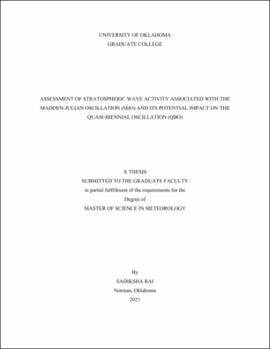| dc.contributor.advisor | Sakaeda, Naoko | |
| dc.contributor.author | Rai, Sadiksha | |
| dc.date.accessioned | 2021-12-16T14:55:31Z | |
| dc.date.available | 2021-12-16T14:55:31Z | |
| dc.date.issued | 2021-12 | |
| dc.identifier.uri | https://hdl.handle.net/11244/332334 | |
| dc.description.abstract | The Madden-Julian Oscillation (MJO) and Quasi-Biennial Oscillation (QBO) are known to provide sub-seasonal to seasonal predictability, yet their dynamics and interactions are not fully understood. Many recent studies have found that the MJO amplitude tends to be higher during the easterly phase of the QBO while MJO amplitude tends to be weaker during the westerly phase of the QBO over Maritime Continent and warm pool regions during boreal winter. It is often believed that this relationship arises through the modulation of upper-troposphere and lower stratosphere lapse rate by the QBO, but the impacts of the MJO related deep convection on the evolution of the QBO have not been examined in depth.
Vertical momentum fluxes by stratospheric equatorial Kelvin and Rossby-gravity waves generated by tropical deep convection are known to play important roles in the dynamics of the QBO. We hypothesized that the stratospheric waves can be modulated by the MJO convective activities, which can then influence QBO evolution and contribute to the observed MJO-QBO relationship. Therefore, the main objective of this research is to examine potential changes in the stratospheric wave activity associated with the MJO and its potential impacts on the QBO. Our results so far show that enhanced MJO activity is associated with slightly faster downward propagation of the QBO, supporting our hypothesis. However, wavenumber-frequency spectral analysis of ERA-I and ERA5 do not show any MJO impacts on stratospheric wave activity. These contradicting results may be due to the inefficacy of reanalysis to capture high-frequent stratospheric waves or the lack of MJO impacts on stratospheric waves.
To incorporate high-frequent stratospheric waves, we further operate our analysis on radar observational data from the atmospheric Equatorial Atmosphere Radar (EAR) and we notice the presence of higher activities of high-frequency stratospheric waves during an easterly phase of the QBO than a westerly phase of it. We also recognize a subtle but significant linear and non-linear association of high-frequency stratospheric waves with the presence of higher convective activities during active than inactive MJO months. Overall, we couldn’t find a strong association of the stratospheric waves (synoptic scale) related to the tropospheric MJO activities, which we hypothesized as the driver of the documented relationship between the MJO and the QBO, hence, implying the MJO as not the modulator of its unique relationship with the QBO. | en_US |
| dc.language | en | en_US |
| dc.subject | Stratospheric wave activity | en_US |
| dc.subject | Atmospheric Sciences. | en_US |
| dc.subject | MJO-QBO relationship | en_US |
| dc.subject | Sub-seasonal to seasonal weather | en_US |
| dc.title | Assessment of stratospheric wave activity associated with the Madden-Julian Oscillation (MJO) and its potential impact on the Quasi-Biennial Oscillation (QBO) | en_US |
| dc.contributor.committeeMember | Homeyer, Cameron | |
| dc.contributor.committeeMember | Furtado, Jason | |
| dc.date.manuscript | 2021-12 | |
| dc.thesis.degree | Master of Science in Meteorology | en_US |
| ou.group | College of Atmospheric and Geographic Sciences::School of Meteorology | en_US |
| shareok.orcid | 0000-0003-4496-1447 | en_US |
| shareok.nativefileaccess | restricted | en_US |
